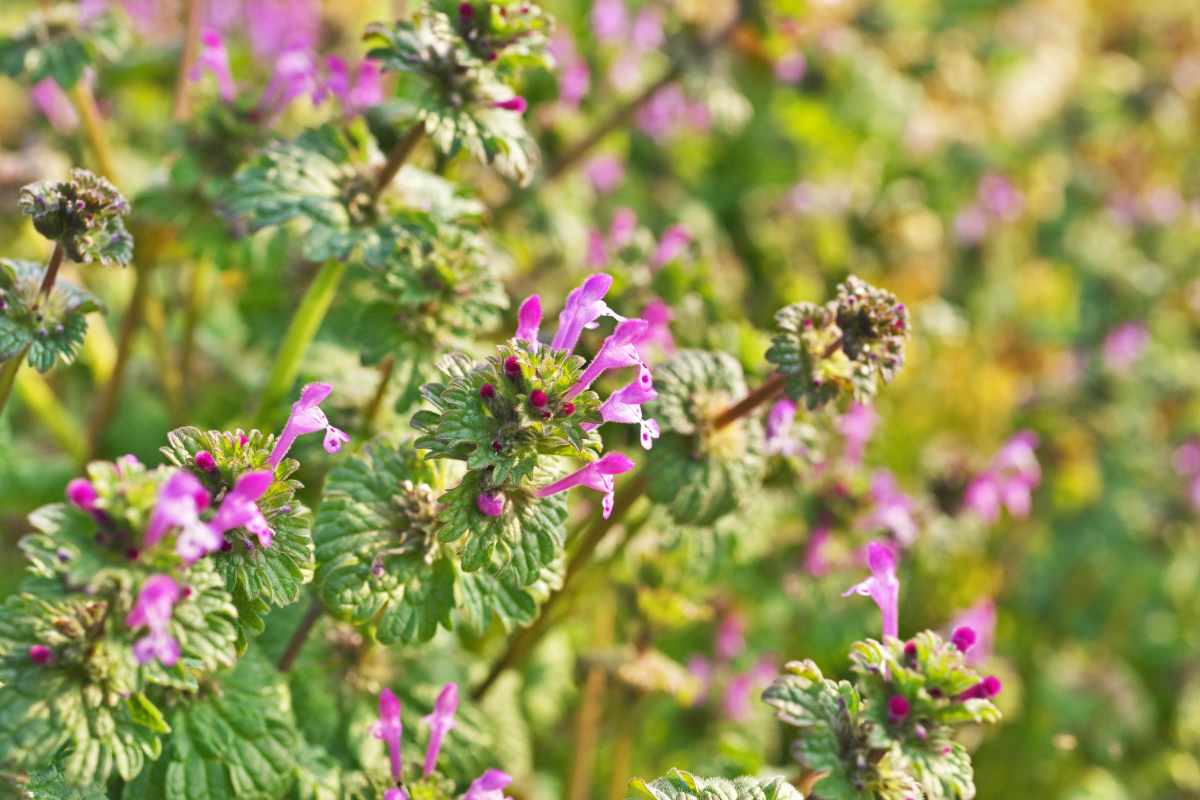
In this article, we delve into 12 common lawn weeds in Texas, providing insights on how to identify and control crabgrass, henbit, thistles, and many more.
A typical image of Texas is a field of bluebonnets blooming in the spring. But it’s no secret to locals that the Lone Star State has more than its fair share of weeds. If your once-lovely lawn is now covered in unsightly weeds, we’ll explain how to rid your lawn of these invaders and regain your pride in your Texas turf.
Most Common Weeds in Texas
To maintain a healthy lawn in Texas, you need to take proactive steps to control various grass and broadleaf weeds before they become a problem. If not properly managed, these invasive species can quickly overtake your outdoor space.
The following sections will explore the most common grass and broadleaf weeds in Texas so you can identify and control them, achieving a healthy and beautiful Lone Star lawn that you can enjoy throughout the year.
Grass Weeds
1. Crabgrass (Digitaria texana)
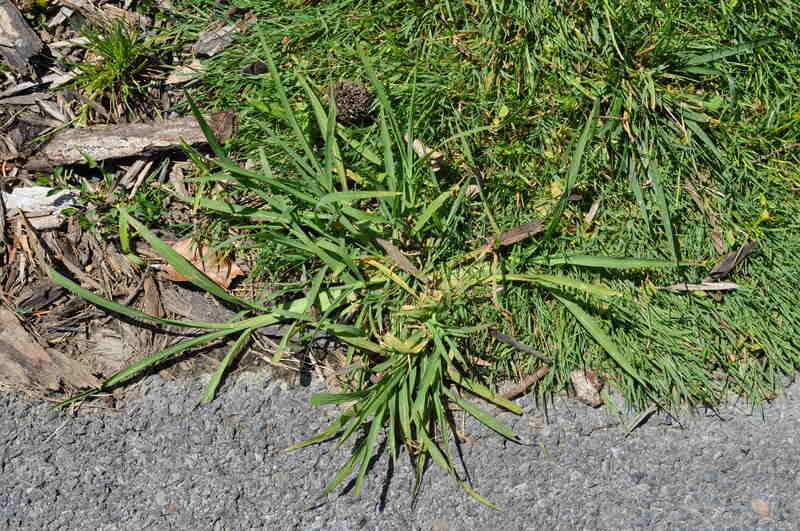
Crabgrass, an annual grassy weed, can quickly take over your lawn and flower beds. It thrives in hot, dry conditions and typically grows in compacted soil with plenty of light. This makes Texas a dream location for crabgrass but a nightmare for homeowners. It grows in the spring and dies in the fall, but only after producing up to 150,000 seeds per plant.
- Life cycle: Summer annual
- Weed type: Grass weed
- Where it thrives: Compacted soil with full sun
- How to identify crabgrass: Long, finger-shaped leaves that can grow up to 6 inches long. They are light green to yellowish-green and have a prominent midrib. The stems are flat and can grow up to 2 feet long. Crabgrass has a low, spreading growth pattern.
- How to get rid of crabgrass: Prevent crabgrass growth with pre-emergent herbicides in the early spring. Use post-emergent herbicides to get rid of existing crabgrass. Hand-pulling is also effective if done early. Deter crabgrass growth by maintaining a healthy, dense lawn.
2. Goosegrass (Eleusine indica)
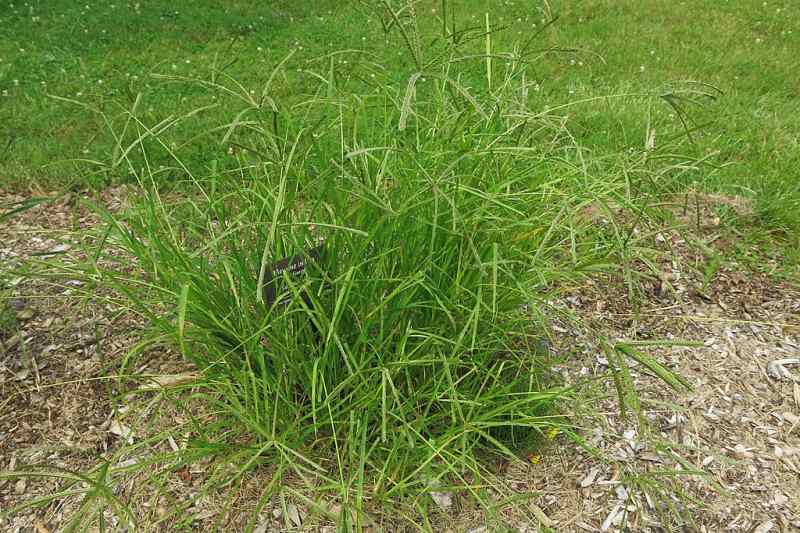
Goosegrass, also known as wiregrass, silver crabgrass, and crowfoot, is a common type of summer annual that invades the warm-season grasses that grow in Texas. This clumping grass has flat stems and is frequently found in lawns with sparse grass coverage, particularly in areas with a lot of foot traffic.
- Life cycle: Summer annual
- Weed type: Grass weed
- Where it thrives: Compacted soil and lawns where turf is thin
- How to identify goosegrass: It grows in clumps and has flat stems ranging from white to silver at the center.
- How to get rid of goosegrass: Start by implementing good lawn care practices. Then, use pre-emergent or post-emergent herbicides to address outbreaks of goosegrass. Aerating your Texas lawn reduces soil compaction and improves turfgrass root growth, leading to a fuller, thicker lawn that helps outcompete this weed.
3. Nutsedge (Cyperus esculentus)
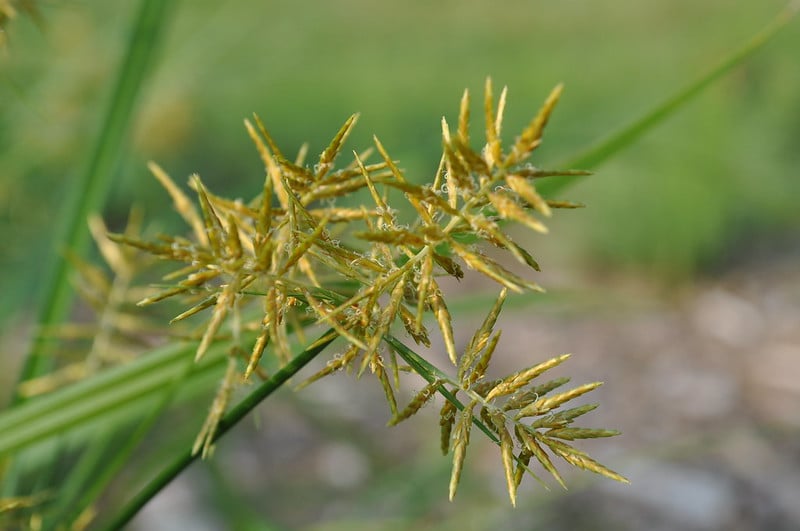
Nutsedge is a common weed in Texas that looks like grass but is a member of the sedge family. If left unchecked, it can quickly take over a lawn or garden. It is difficult to control nutsedge because it develops rhizomes that can grow new plants and underground tubers. Purple and yellow nutsedge are widespread in North and Central Texas.
- Life cycle: Perennial
- Weed type: Grass weed
- Where it thrives: Damp soil and can tolerate sunny and shady environments
- How to identify nutsedge: Nutsedge can be identified by its triangular stems and purple or yellow flowers. Nutsedge grows faster than grass and is often taller, with glossy or waxy leaves.
- How to get rid of nutsedge: Start by identifying areas of your lawn with excessive moisture. If you catch nutsedge early enough, hand removal is an excellent control method. Herbicides can be effective, but multiple applications may be necessary to eradicate the weed. Find out how to spray for lawn weeds to avoid harming your lawn.
4. Sandbur (Cenchrus var.)
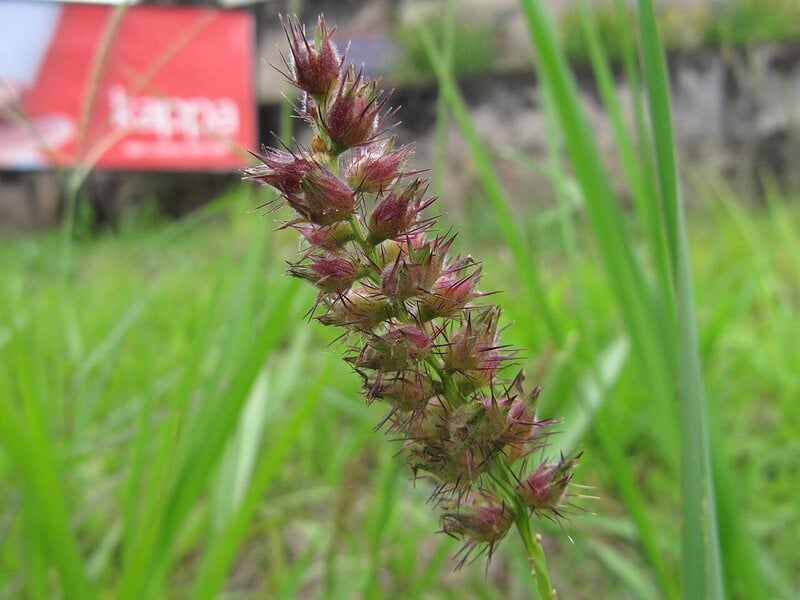
Sandburs, also known as grass burs or stickers, are very common in Texas. The annual (C. echniatus) and perennial (C. spinifex) species thrive here and are a constant nuisance to many people. Sandburs are grassland plants with spike-shaped flower clusters and sharp spines that can stick to clothing, pets, or anything that brushes against them, causing irritation and pain.
- Life cycle: Annual or perennial, depending on the cultivar
- Weed type: Grass weed
- Where it thrives: Prefers poor, dry, sandy soils and is often found in areas with poor drainage and in overgrazed or disturbed areas, such as pastures and fields.
- How to identify sandbur: Look for their burs, which are spiky flowers, or their thin, pointed leaves.
- How to get rid of sandbur: Pull them out by hand or use herbicides. Pulling by hand is time-consuming. You can use a pre-emergent herbicide in the spring or apply post-emergent herbicides once they have sprouted to control the weed before it seeds. Improve drainage in your yard to deter sandbur and other weeds from settling in.
Broadleaf Weeds
5. Dandelion (Taraxacum officinale)
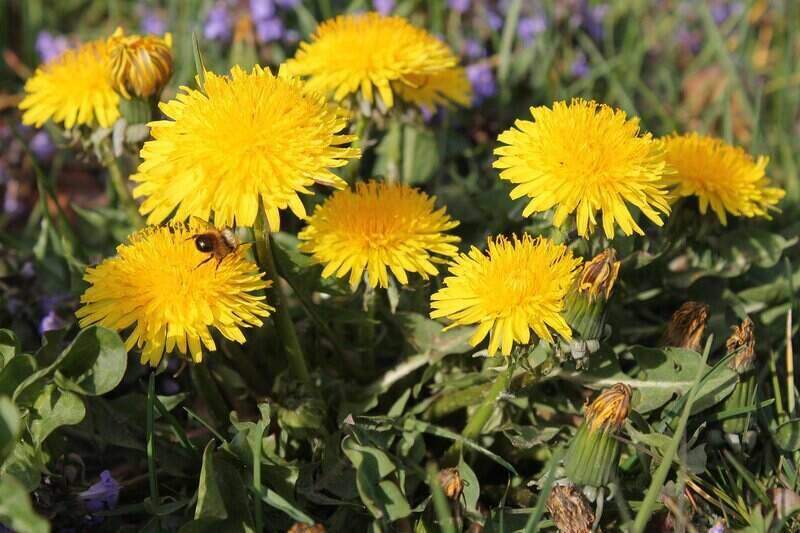
Dandelions are a common weed in Texas and are often considered a nuisance due to their ability to spread quickly and take over an area. However, dandelions are also beneficial: Their leaves are often used in salads and teas for nutritional value. Many homeowners in Texas get rid of dandelions because they can form thick mats of leaves that crowd out turfgrass.
- Life cycle: Perennial
- Weed type: Broadleaf
- Where it thrives: Prefers full sun to partial shade. Dandelions grow in most soil types and are found everywhere here.
- How to identify dandelion: The plant can grow up to 18 inches tall and is recognized by its bright yellow flower. Its leaves are deeply notched, alternate, and can measure up to 12 inches in length.
- How to get rid of dandelion: Remove the entire taproot by using a dandelion digger or hand pulling. Post-emergent herbicides control mature plants, while pre-emergent herbicides prevent seeds from germinating in the spring.
6. Henbit (Lamium amplexicaule)
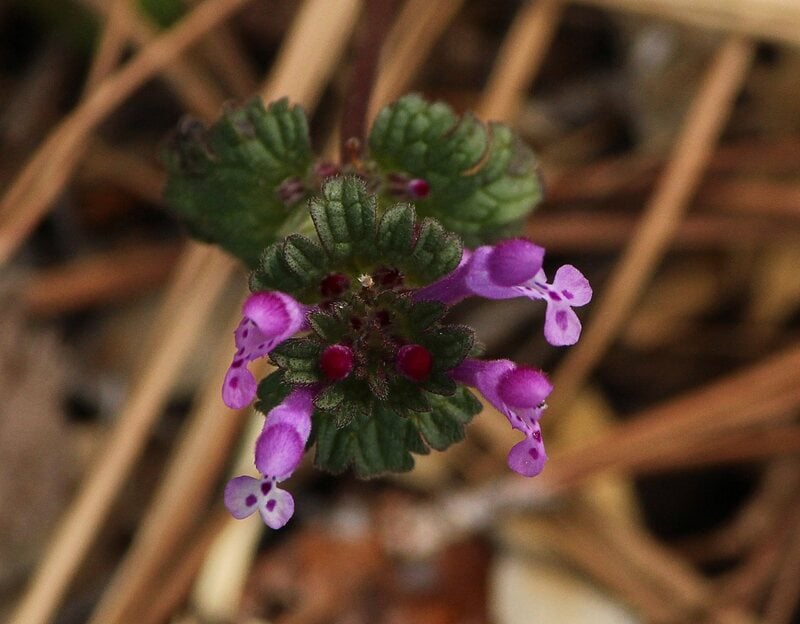
Henbit is a weed commonly found in Central Texas that belongs to the Lamiaceae (mint) family. It has five different species of relatives. Henbit can be recognized by its upper leaves that wrap around the stem to form a rosette. It is also used as a medicinal herb and is frequently eaten as a snack by chickens, hence its name.
- Life cycle: Winter annual
- Weed type: Broadleaf
- Where it thrives: Moist, cool areas but tolerates full sun
- Identifying henbit: Henbit has small pink to purple flowers and square stems. It grows, on average, 6 to 8 inches tall, but it can reach up to 16 inches.
- How to get rid of henbit: Use post-emergent herbicides to control henbit, but follow instructions carefully to avoid damaging other native Texas plants and your turf. Regular mowing and maintenance can also help prevent the growth and spread of this herb.
7. Spotted Spurge (Chamaesyce maculata)
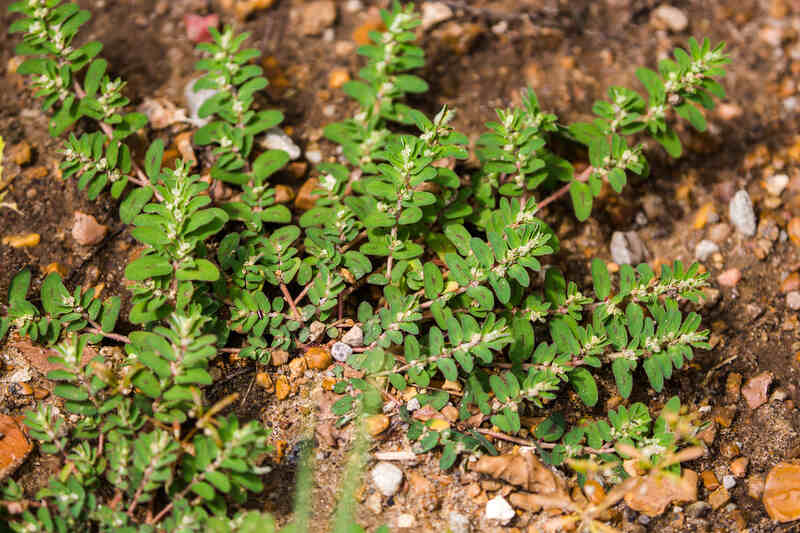
Spotted spurge is a common weed that grows well in hot Texas summers. It spreads out from a central point to form a thick mat. Spotted spurges are commonly found in compacted soil and are most noticeable during summer. They have a milky white sap that can cause skin irritation upon contact.
- Life cycle: Summer annual
- Weed type: Broadleaf
- Where it thrives: Hot, dry conditions in compacted or poor soil
- How to identify spotted spurge: Look for small, oval leaves that grow in pairs along the stem. The stems are reddish and have small, pinkish-red spots on them. The plant grows low to the ground and can form mats that cover large areas.
- How to get rid of spotted spurge: Use post-emergent herbicides when the plant is actively growing and before it produces seeds. Hand-pulling can also be effective for small infestations. To prevent spotted spurge from taking hold in your lawn, maintain a healthy turf to compete with weeds.
8. Ground Ivy (Glechoma hederacea)
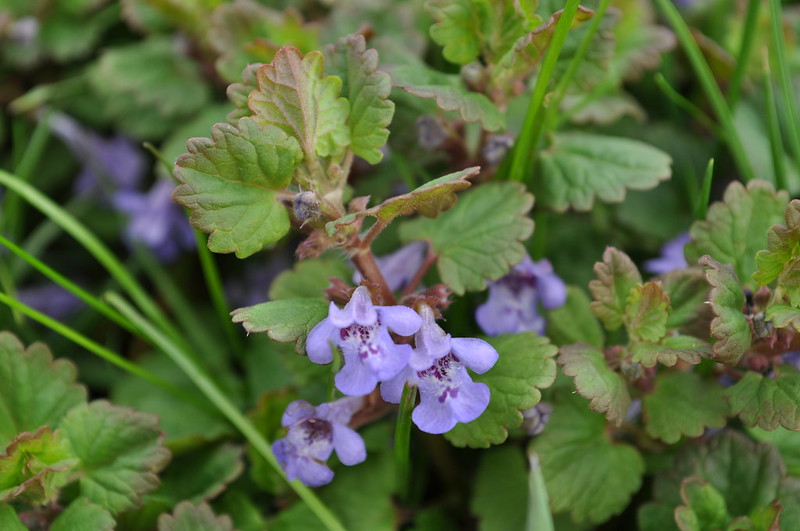
Ground ivy is a creeping broadleaf perennial with small purple flowers. Due to its therapeutic properties, herbalists have used this plant to treat various ailments. However, it must be controlled, as it can take over your Texas lawn and garden beds, creating a dense mat that can hide pests and diseases.
- Life cycle: Perennial herb
- Weed type: Broadleaf
- Where it thrives: Shady areas with moist soil
- How to identify ground ivy: Recognizable by its creeping growth and small purple flowers. The plant’s leaves are heart-shaped and opposite each other, measuring about an inch across, with scalloped edges. If crushed, the leaves give off a musky mint fragrance.
- How to get rid of ground ivy: Once they have taken hold, root and stolon pieces can be difficult to remove. Even if you take steps to remove the entire root system, seed pods may remain. Small parts of the plant can be pulled out by hand or with a rake when the soil is damp to eliminate the roots. For large invasions, post-emergent herbicides like glyphosate work well.
9. Plantain (Plantago spp. L)
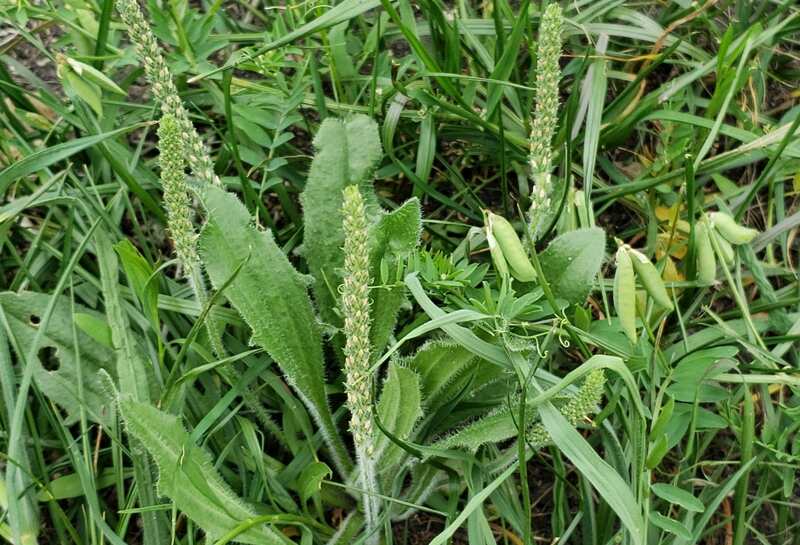
In Texas, there are 13 species of plantain, also known as tallow weed. Some plants are winter annuals, while others are perennials. Popular types include redseed, cedar or Heller, and Hooker’s plantains. The plants have stemless leaves that grow from a crown, and the leaves’ texture and size differ depending on the species.
- Life cycle: Winter annual or perennial weed, depending on the cultivar
- Weed type: Broadleaf
- Where it thrives: In damp, compacted soil in lawns, pastures, by the side of the road, and abandoned locations with disturbed soil
- How to identify plantain: Plantain flowering stems have spreading hairs, and the flowers have four parts. The fruit is a capsule with one to a few seeds.
- Redseed plantain (Plantago rhodosperma) has hairy, toothed, or narrow and elongated leaves ranging from 1/3 to 2 inches wide.
- Cedar or Heller plantain (Plantago helleri) has shorter, more villous, and narrow leaves.
- Hooker plantain (Plantago hookeriana) usually has narrow, hairless, or wooly leaves that vary in length depending on growing conditions.
- How to get rid of plantain: Remove seedlings and plants while they are young and before they go to seed to get rid of plantains. This process can take months to get them all. Use a post-emergent herbicide on mature plantains. Mowing is not practical because the leaves are too close to the ground. Clean tools after use so seeds don’t spread to other areas.
10. Goathead (Tribulus terrestris)
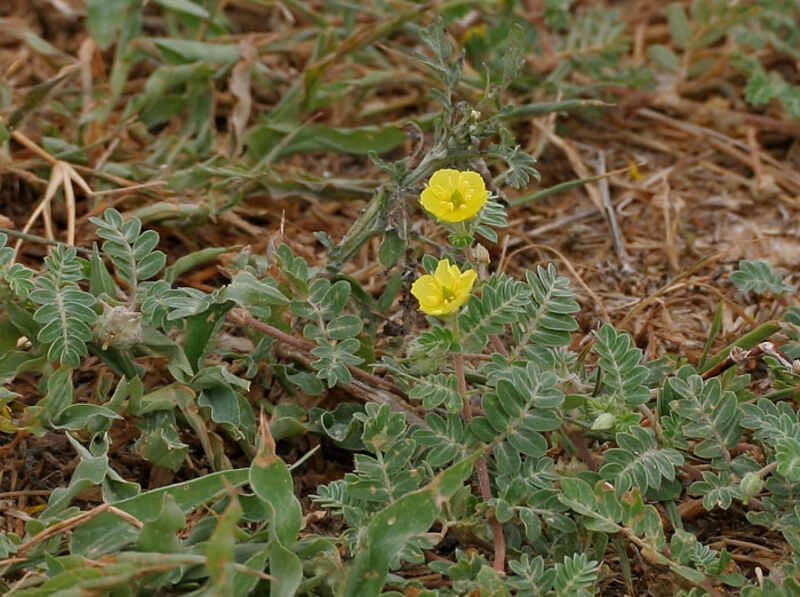
Goathead, also known as puncturevine, is a plant that grows in a mat-like form during the early summer. It has large leaves and widespread roots. Many Texans know the sharp spines of the dried bur resemble a goat’s head and can cause injury to people and pets, as well as puncture bike tires. The plant’s leaves contain saponins, a harmful substance toxic to cats, dogs, and sheep.
- Life cycle: Summer annual
- Weed type: Broadleaf; mat-forming
- Where it thrives: Hot, dry areas with compacted soil and disturbed areas, such as fields and pastures
- How to identify goathead: Little yellow flowers bloom from July through October. Its fruit bears sharp spines and resembles a goat’s head when dried out.
- How to get rid of goathead: Uproot plants by hand or with a hoe, taking care not to transfer them on your shoes, tools, or tires. Use natural or synthetic mulches that block light to restrict seed growth. Apply pre-emergent weed killers (mid-spring or winter) for the best result. Post-emergent herbicides are effective for young plants.
11. Thistles (Cirsium spp. Mill.)
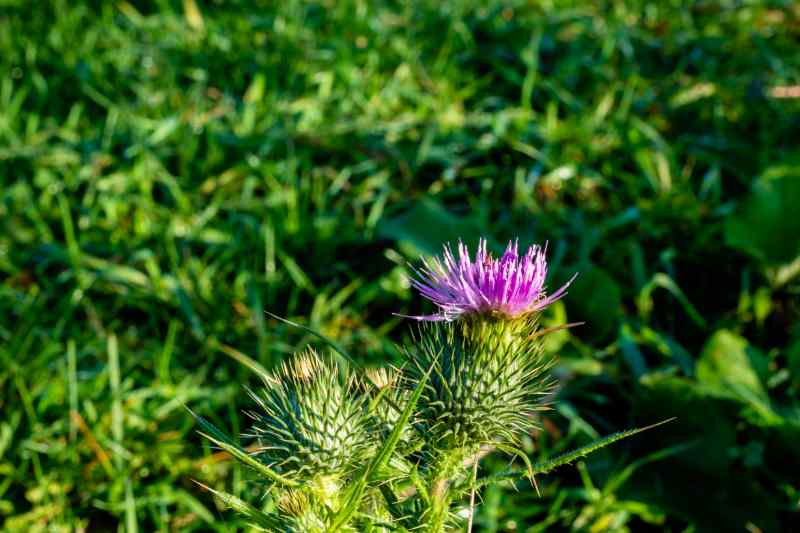
Thistle is a flowering plant in many parts of the world, including Texas. Texas is home to 10 species of thistles. A common species, the Texas thistle (C. texanum), is a taproot biennial that can grow 2 to 5 feet tall. Thistle is well-known for its prickly leaves and brightly colored flowers, ranging from pink to purple or white.
- Life cycle: Biennial
- Weed type: Broadleaf
- Where it thrives: Thistles can be found in dry and wet soils in Texas. They flourish in disturbed or overgrazed areas, lawns, vacant fields, and ditches along roadways.
- How to identify Texas thistle: The Texas thistle is a tall plant growing from 2 to 5 feet. It has alternate leaves between 4 and 9 inches long, becoming shorter near the stem’s top. The leaves are green on top and white on the bottom, with a fuzzy texture underneath. Each stem has one flower head with several violet disc flowers.
- How to get rid of Texas thistle: The best method is hand-pulling the plants or using herbicides designed specifically for thistles. If you’re using herbicides, the best time to do so is when they’re in the rosette stage. Properly dispose of any plant material to avoid the transmission of seeds.
12. Chickweed (Stellaria media)
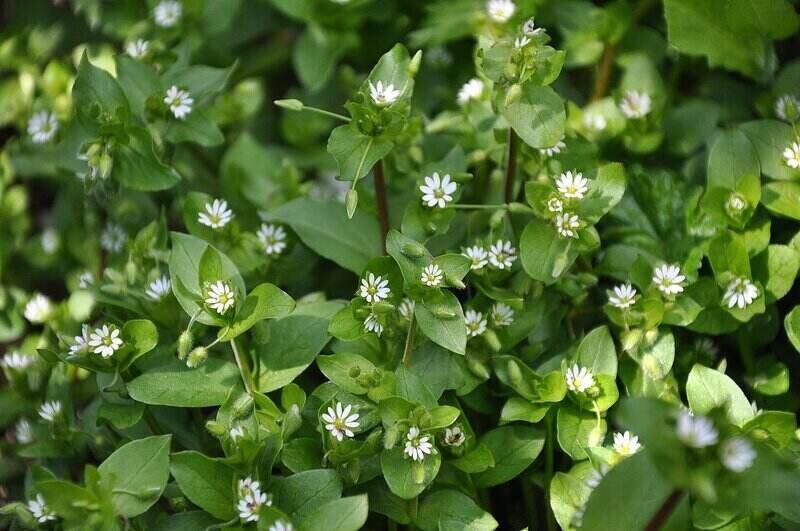
A winter annual, common chickweed is a widespread broadleaf weed that thrives in Texas’ damp, shady, and rich soil into late winter. It stands out thanks to its tiny white blossoms. Chickweed is frequently seen in sparse or bare patches of grass.
It develops in the fall, becomes mature during the winter, and produces seed heads in the spring through the first few months of the summer.
- Life cycle: Winter annual
- Weed type: Broadleaf
- Where it thrives: In moist, shaded areas with rich soil
- How to identify chickweed: Chickweed has small, oval-shaped leaves that grow opposite each other on the stem. The leaves have a pointed tip and a smooth margin. The stem of the chickweed is thin and green, and it produces small white flowers.
- How to get rid of chickweed: Hand-pulling is a simple and practical approach. To prevent weed seeds from germinating in ornamental bed areas, apply a 2 to 3-inch layer of mulch. Pre-emergence herbicides are available depending on the type of turfgrass and ornamental plants grown. The optimal timing for post-emergence herbicides is mid-fall.
FAQ About Weeds in Texas
1. What Are Tumbleweeds?
Tumbleweeds are plants that, when mature, dry out, sever their roots, and are blown away by the wind. Russian thistle (Salsola tragus) is the most well-known species of tumbleweed, although others exist. To learn more, read our article on Everything to Know About Tumbleweeds.
2. How Can I Get Rid of Weeds Without Killing My Grass?
Hand pulling is the most effective method for small lawns with minimal weed growth, especially for annual broadleaf weeds. Pre-emergent and post-emergent herbicides should be used cautiously, as they are often formulated for specific situations or weed types. Always follow the instructions to avoid damaging your Texas grass or the local ecosystem.
3. Can I Use Weed and Feed on My Texas Lawn?
Herbicides and fertilizers are often combined in weed-and-feed products. However, the recommended timing and rates for fertilization do not coincide with the best time for weed control, which increases the risk of herbicide overdose when using these products. A safer alternative to weed-and-feed products is corn gluten mixed with organic fertilizer.
To learn more about fertilizer timing, check out our guide on When to Fertilize Lawns in Texas.
When to Call a Pro
Keeping your Texas lawn lush and healthy is a challenge, no matter what part of the Lone Star State you live in. Adding weed control to watering, mowing, and fertilizing is a pain. Call a Texas lawn care pro near you if you prefer to spend your weekends having a BBQ rather than pulling weeds.
Main Image Credit: igaguri_1 / Canva Pro / License